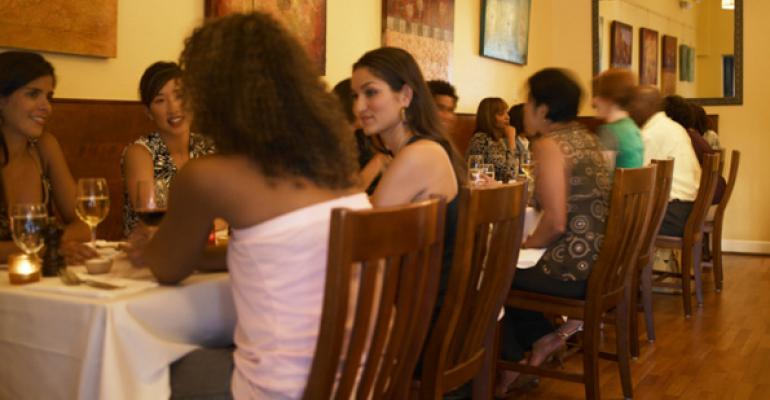Look out. Discounts and deals seem to have lost their promotional punch in the casual dining segment, where foodservice information provider NPD recently reported a steady two-percent-per-year decline in customer visits since 2009. One tactic that could help operators fill all the empty seats: cozy up to the corporate dining crowd, whose year-over-year spending to entertain clients in restaurants rose 5.2 percent in the first quarter of 2014.
Casual dining chains better do something to move the needle, because the segment has posted a cumulative loss of 7.1 million customers since the depths of the recession. There’s been no rebound, despite endless rounds of incentives and deals designed to boost traffic. These offers have enabled large casual dining chains to tread water during this five-year period—visits there have been flat—but small chains and independents have seen their numbers decline at a three percent annual clip.
NPD says big chains do better because they are able to offer more deals and advertise them more aggressively than smaller operators can.
But deals can only do so much. The report notes that promotional offers reached an all-time high at major casual dining chains in 2013, accounting for 29 percent of traffic. That’s a greater percentage of deal traffic than is seen in the quick-service segment (27 percent) or among casual dining independents (17 percent). All this activity provides an occasional boost to casual dining segment traffic but, overall, there’s been a steady decline.
NPD restaurant industry analyst Bonnie Riggs thinks promotions are the problem.
“It appears casual dining operators’ promotional offers have been in place for too long. For example, the ‘two for $20’ craze is now available in some variation at nearly every casual dining chain,” she says. “Some liken it to an echo chamber because there’s no competitive differentiation. Relying on existing promotional tactics may no longer be a viable option.”
Riggs notes that casual dining’s position in the middle of the market isn’t helping. The segment is losing some customers to less-expensive restaurants, particularly fast casual operations. Other customers now consider a meal at a casual dining concept as more of a special occasion, so they may trade up to fine dining instead.
What should operators do?
“Casual dining operators must reinvent offerings that have lost their luster and introduce new promotions and menu items to attract customers and encourage repeat visits,” says Riggs. “Consumers will wait you out once you have shown your willingness to provide regular discounts. Until you reach the price point that delivers the value they have come to expect, they will stay away or find other restaurants that meet their value expectations.”
Value seems to be less of a concern for big business. Corporate dining connection-making firm Dinova reports that overall restaurant spending by its clients rose 5.2 percent year-over-year in the first quarter of 2014 and check averages were up 2.7 percent to $52.86.
Looking ahead, the overall trend is up.
“These figures clearly demonstrate the value of corporate dining, as businesses fought through bad weather and continued to entertain clients and prospects,” says Dinova c.e.o. Vic Macchio. “The trend from 2013—with corporate travelers dining out more often, and spending more when they do—continued throughout the first quarter and is strengthening as the second quarter unfolds.”
Macchio’s outlook is based is based on the corporate dining expenditures of his company’s clients, who collectively spend $1.5 billion each year.
There’s still plenty of life left in casual dining, as evidenced by the recent private equity purchase of two of the segment’s iconic brands, Red Lobster and TGI Friday’s. We don’t know how these buyers intend to get these big chains back on track, but they and other operators may wish to take Riggs’s advice on promotions to heart. A second item for their agenda: figuring out how to get more business from the free-spending corporate dining segment.





